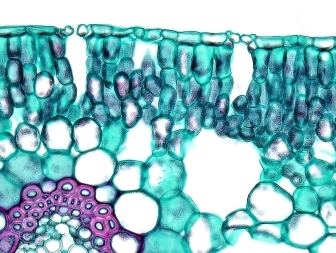Stomata and transpiration
25 May 2020 - Articles
Stomata play an important role in the water balance and photosynthesis in plants. The greenhouse climate has a significant impact on the opening and closing of the stomata and therefore on the water balance and nutrient composition of the plant sap.
In addition to normal cells, the leaf surface of a plant also has special features, namely the stomata. Each stoma consists of two guard cells. Behind the guard cells air cavities are present in the mesophyll tissue (see image). The condition of the stomata – in other words, whether they are open or closed – is the most important internal condition affecting transpiration.
Another process dependent on the condition of the stomata is photosynthesis. For photosynthesis to take place, the plant needs water and CO2:
6H2O + 6 CO2 -> C6H12O6 + 6 O2
Photosynthesis stops when the stomata are fully closed. However, research has shown that for the plant to assimilate CO2, the stomata only need be open slightly. Transpiration, and therefore water loss, will then be limited.

Figure 1: Stomata in a leaf. Photo: BCC Bioscience Image Library
Opening and closing
The rate of transpiration in a crop is mainly controlled by the difference in relative humidity (RH) between the air cavities in the leave and the greenhouse air. When solar radiation increases, the air temperature in the greenhouse rises and the difference in RH between the air cavities in the leave and the greenhouse air becomes greater, as warmer air can contain more moisture. The leaves then evaporate more, and the number of nutrients in the cells – the osmotic value – rises, which then causes the plant to retain more water and to educe evaporation. This is called a feedback effect.
When the air temperature in the greenhouse drops, the difference in RH between the greenhouse air and the air cavities in the leave becomes smaller, resulting in a lower rate of evaporation. This can cause the leaf temperature to rise, thus reducing the RH in the leaf. The difference between the RH in the air cavity and in the greenhouse air becomes greater and the stomata will open to increase the rate of transpiration – a second feedback effect.
CO2 concentration
Besides the leaf temperature, the opening and closing of the stomata is also influenced by the amount of CO2 in the greenhouse. When CO2 concentrations increase, the stomata will to a greater or lesser extent close, thus reducing crop transpiration. But if the leaf temperature then increases again, some of the stomata will reopen and the transpiration rate will increase again.
Water is not only needed to transport nutrients and to keep the plant cool, it is also a basic component of every cell. For example, it is responsible for ensuring turgor. When a plant transpires, its turgor is reduced and the plant becomes softer and more limp. In general, water uptake lags slightly behind transpiration.
If evaporation is reduced as a result of the feedback mechanisms of the stomata, water uptake in the plant is temporarily larger than the evaporation rate and the plant can top up its water levels, thus increasing its volume and weight. The best time for a plant to top up its water levels is in the evening when it is transpiring less and the stomata are for the most part closed.
Composition of plant sap
Water uptake and evaporation play an important role in the composition of plant sap. This is determined to a large extent by the climate and the condition of the stomata. It is therefore important to always carry out sampling for PlantsapCheck analyses at the same time of day. Read more >
More information
Please contact horti@eurofins.com
